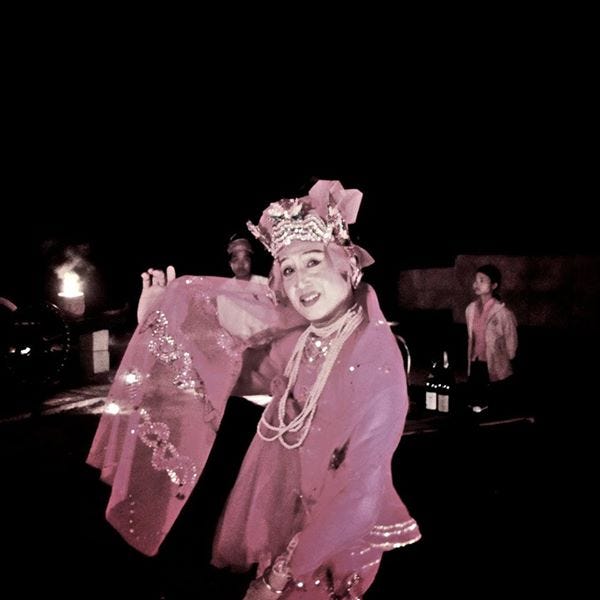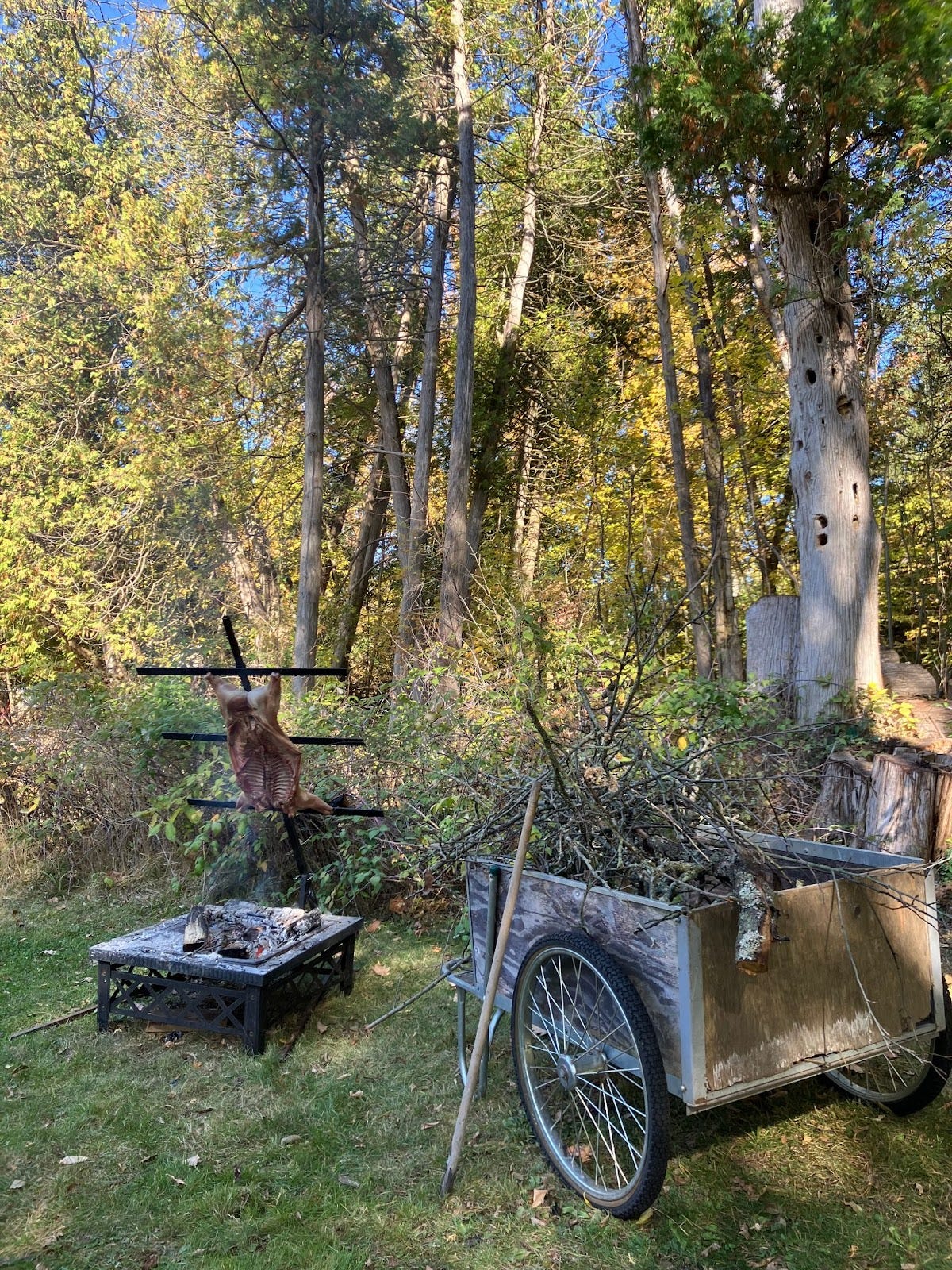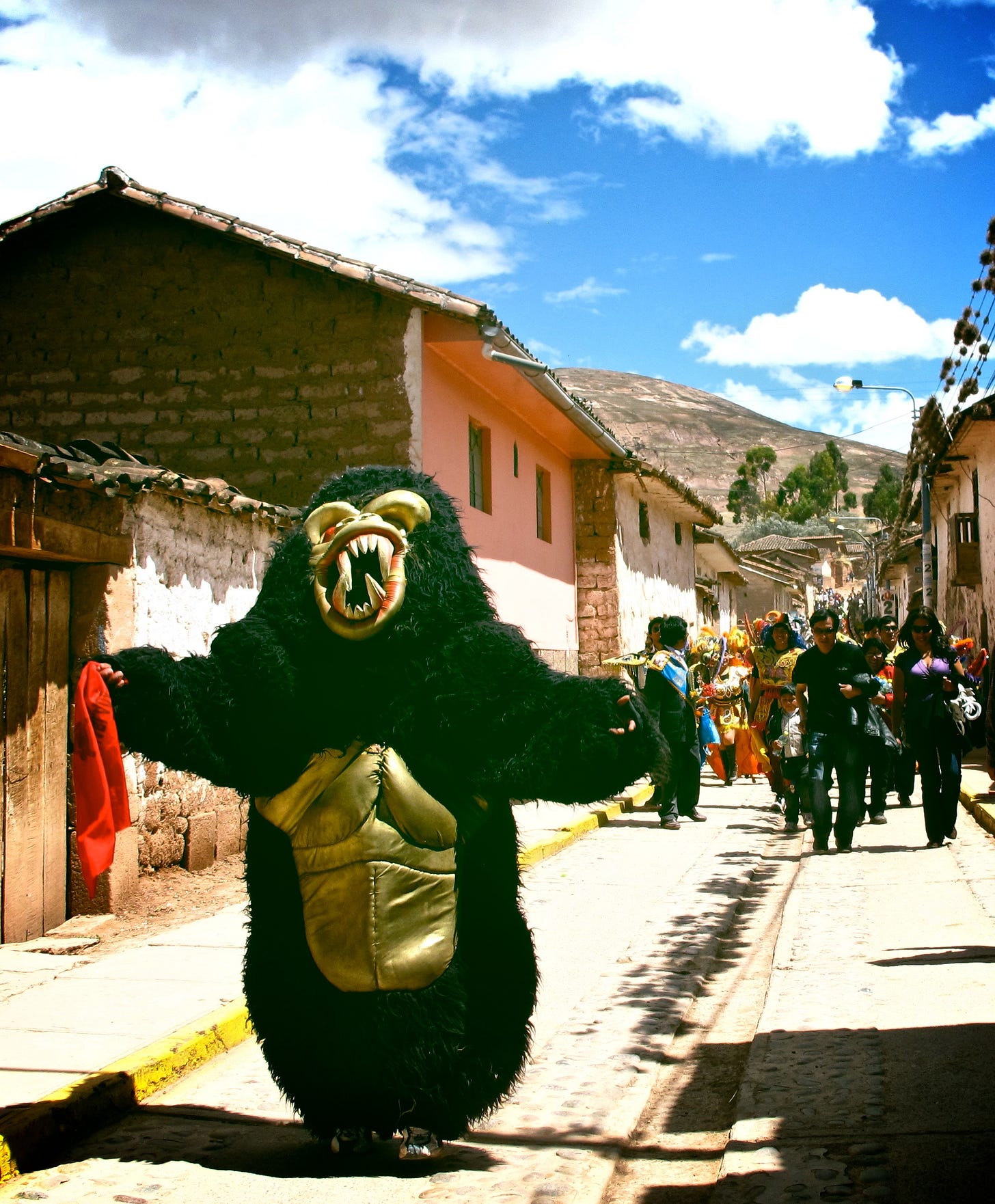eater of the dead
On circadian rhythms of rot, transubstantiation, and the universal want to absolve our sins. Happy Halloween all!
For 10 years I lived out of a bag. It was a good bag (a cordura Patagonia roller) that did me well, and it was the same size as a small NYC apt and held all the stuff I needed at that point in my life so I was happy. I started on the road without much religion or superstition, and perhaps it was far too many times getting stomach bugs, but along the way I picked up little shamanistic rituals that have stuck with me making my religion one of strange spirits, drunken gods, and indulgent Buddhists habits.
There are a handful of things one can find anywhere while on the road: Irish pubs, Bob Marley music, egg and tomato dishes, and gods/spirits that are worshiped for their over indulgence. They are not bad, not like devils, but to me they end up seeming like rowdy heathen prophets that are forgiven their mistakes because of being lovable in some way.
These are the ones that stuck to me and in deep dark places that I don’t talk about at parties:
Bhutan: Drukpa Kunley (the divine Madman): The Drunken warrior of Buddha walking the countryside using sex, drugs, and rock and roll to bring enlightenment. It is said that upon organism with the Divine Madman one would reach enlightenment. There is a valley near Punakha that is the valley of the phallus, where a giant stone phallus is presented to those who wish to be more fertile. The stone form is said to have risen from a lake in the hands of a god like a pornographic Excalibur.
Myanmar: Ko Gyi Kyaw: The Burmese spirit of drink and cockfights. Ko Gyi Kyaw is blessed with cigarettes, whiskey and chicken; loves a good cockfight. Every year outside of Mandalay there is a festival for this favorite Nat (spirit or sprite). He is like Puck from A Midsummer nights dream, mischievous and full of pranks.
Argentina: Gauchito Gil: Based on the supposed life of Antonio Gil who’s life was cut short by corrupt police and thus became the folk-saint for all those anti-establishment moments in life. There are festivals in honor of Gauchito Gil and if ever driving in Patagonia you will see these small red houses (or shrines) on the side of the road every 10k or so, sometimes used as drug drops.
Guatemala: San Maximon: The mustached patron saint of prostitutes and drunks in Guatemala. There is an effigy passed around the rural villages of Guatemala where one is to bring smokes and drinks and gambling questions. But there is a yin to this yang, he is also the saint for couples and marriage and community.
China: Li Bai: The rice wine drinking poet of ancient China who found inspiration in libations. Not a myth but a real flesh and bone poet praised by Confucianism. Here is one of my favorites:
Waking From Drunkenness on a Spring Day (春日醉起言志)
處世若大夢, Life in the world is but a big dream;
胡爲勞其生. I will not spoil it by any labour or care.
所以終日醉, So saying, I was drunk all the day,
頹然臥前楹. lying helpless at the porch in front of my door.
覺來盼庭前, When I awoke, I blinked at the garden-lawn;
一鳥花間鳴. a lonely bird was singing amid the flowers.
借問此何時, I asked myself, had the day been wet or fine?
春風語流鶯. The Spring wind was telling the mango-bird.
感之欲嘆息, Moved by its song I soon began to sigh,
對酒還自傾. and, as wine was there, I filled my own cup.
浩歌待明月, Wildly singing I waited for the moon to rise;
曲盡已忘情. when my song was over, all my senses had gone.
The providence found in the drunken gods of the globe is an endearing sort; utilitarian and comforting in the way a dive bar or old rock & roll t-shirt can be, and perhaps that is why they stuck to me rather than any of the other saints. These gods feel worn-in like the grooves of all of those overplayed Bob Marley records spanning the far corners of the planet, like old denim jeans.
There are connections in the things we value, praise, and ritualize, that replicate or are found in seemingly disconnected corners of the world. I remember in my university years hearing about Appalachian traditions and melodies that sounded like Irish folks songs, because they were, they had been carried there in the people and the stories we tell.
In the Cumberland gap, you can find stories of sin-eaters in the hills. These were people in a community who were employed to come at the death of another, approach the body, incant, and consume a loaf of bread that the family leaves on the body of the deceased, thought to have absorbed the evil of the flesh into the dough. No one would make eye contact as this eater was consuming evil incarnate, and to look in the eye one would receive part of that evil. The sin eater would eat the bread which had absorbed the deceased sins, thus carry the sins with him as he left, a vessel, leaving the family and the spirit clean of sin ready for the journey onwards to the afterlife, to be judged by god or gods. This, like the melodies of bluegrass and folk, came from Ireland, Scotland, and Wales, but was more ancient than that.
In Ireland this is part of of a belief system of spells called piseogs. If you found a fouled egg in the chicken coup it was seen as an evil presence, something needing magic to exorcize. Tales of malformed cattle or livestock would bring spiritual anxiety to a farm.
In Nepal, when a King dies, there is a similar process as the Irish and Appalachian sin-eaters. A special priest is brought in to wear the clothing of the dead King, eat his favorite foods, wear his crown, use his furniture, and after a time, consume a meal (rumored to be infused with body parts of the King himself). He then mounts an elephant and becomes exiled from the Kathmandu valley never to return, showered with curses and stones thrown from the citizens as he crosses the Bagmati, the sacred river that flows from the Himalayas down to the plains. The priest is shunned, banned, and cursed. This is called the katto.
In Catholicism there is the transubstantiation of communion, bread to flesh and wine to blood. The ceremony of the eucharist is a theatrical version of the same motion, a consuming of spiritual qualities, sins and/or grace. Eat this in remembrance of me. The idea is not representational, the ceremony insists that the bread becomes the physical flesh of Christ, and the wine becomes the actual blood.
All are in a constant state of either becoming or decay.
In the processes of decay and fermentation, there is a certain transmutation that occurs from yeast eating and becoming, turning glucose into ethanol and carbon dioxide, turning water into wine. It is the same process that makes the loaf that raises the bread eaten by the sin-eaters of old.
Every autumn, as the leaves turn and the rot begins in that great circadian rhythm, a few friends and I take our children into the woods for a weekend to gather the last windfall apples of the season. We bring a Patagonian Asado structure inspired by Chef Francis Mallmann. We welded it from scrap iron and we roast a whole pig, nose to tail, slowly over an open flame. This takes 6-7 hours which is perfect for the time we need to slice the apples, then scrat them, and then take the pomace, press it and process it into juice in our large glass jugs. The kids participate and play and watch and help, and we go through a ritual. The kids have grown up with this, they have their own rituals as well. They have made up a game they only play once a year, something called Red Ranger, the rules of which I am not clear as it is theirs and no adult is allowed to participate. We have made shirts and call the whole thing ciderfest, and while we could always just buy the apple juice, or even just go out and buy the cider, there is something in the time consumption and ritual of slicing and burning and pressing and eating and waiting and watching the noble rot slowly occur. That day, while the pig is roasting, the glucose begins to transmute, and over time, a few months, the apple juice will turn to alcohol, and we gather, usually mid winter, to drink it and feel its effects like some pantheon of pagan gods.
I can fully see the relationship with the gods and poets I noted from my life on the road, the Gauchito Gil’s, the Divine Madmen’s, and the drunken Li Bai in his foggy wisdom. I can see the transmutation as each October I watch us all dress up and march around our communities cloaked as evil spirits asking for piles of sugar, to trick and/or treat in the same hope a sin-eater works through a loaf of bread; to become the evil and digest it and purge it from our lives for the winter to come.








